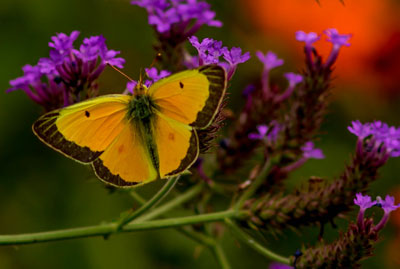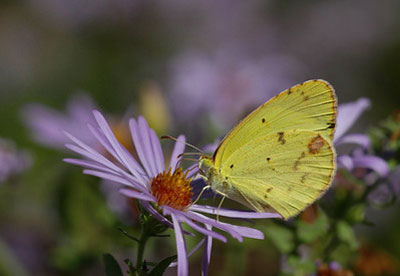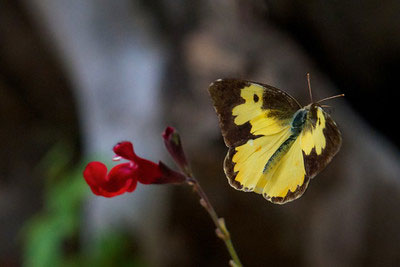Sulfur butterflies are the rays of sunshine in the butterfly world, with their brilliant yellow and orange hues lighting up fields and meadows across North America. These speedy flyers are not just easy on the eyes—they’re key players in our ecosystems, dancing from flower to flower as they pollinate and brighten our landscapes. In this guide, we’ll explore the top sulfur butterflies of North America, diving into their vibrant appearances, fascinating behaviors, and the plants they need to thrive. Get ready to meet the sunny stars of the butterfly world and learn how you can roll out the yellow carpet for them in your garden.

Clouded Sulfur (Colias philodice)
- Boys vs. Girls: The males are bright yellow with a clean black border, while the females are either yellow or white with a more irregular black border and additional dark markings on their wings.
- Home Turf: Found throughout North America, from Canada to Mexico, these butterflies prefer open areas like fields, meadows, and roadsides, making them adaptable and widespread.
- Favorite Fuel: Adult Clouded Sulfurs sip nectar from a wide variety of wildflowers, including clover, asters, dandelions, and milkweed, making them flower foodies.
- Egg Drop Spot: Females lay their eggs on leguminous plants, with white clover and alfalfa being their top choices.
- Caterpillar Chow: The larvae feed primarily on clover, alfalfa, and other plants in the pea family (Fabaceae), sticking close to their legume diet.
- Behavior: Clouded Sulfurs are known for their fast, direct flight. Males often engage in "puddling" behavior, gathering in groups on damp soil or sand to extract minerals. They’re also highly territorial, often chasing away intruders from their feeding areas.
- Habitat: Clouded Sulfurs thrive in open fields, meadows, and along roadsides, preferring sunny, open areas where their host plants grow.
- Flight Period:
- South: March to November (2–3 broods).
- North: May to August (1 brood).
- Winter Stage: The Clouded Sulfur overwinters as a caterpillar, waiting for the warmer spring months to pupate and emerge as an adult.

Orange Sulfur (Colias eurytheme)
- Boys vs. Girls: Males are a bright, vibrant orange with a slim black border, while females are paler with extra black markings. In cooler climates, females may take on a yellowish or whitish hue for added variety.
- Home Turf: They roam from southern Canada to Central America, hanging out in open spaces like fields, meadows, and farmlands.
- Favorite Fuel: Orange Sulfurs love nectar from a wide variety of flowers, including clover, alfalfa, dandelions, and goldenrod—these butterflies enjoy an abundant and diverse floral buffet.
- Egg Drop Spot: Females lay their eggs on legumes, particularly favoring alfalfa and white clover, ensuring the next generation has plenty of food when they hatch.
- Caterpillar Chow: The larvae, like their Clouded cousins, are legume lovers, feeding primarily on alfalfa, white clover, and other members of the Fabaceae family.
- Behavior: Orange Sulfurs are fast, erratic flyers, often seen darting through fields and meadows. Males are known for their "puddling" behavior, where they gather on damp ground to absorb salts and minerals, which play a role in reproduction.
- Habitat: Open areas such as fields, meadows, and farmlands are where Orange Sulfurs feel at home, taking advantage of the wide range of nectar and host plants.
- Flight Period:
- South: March to November (3 broods).
- North: May to September (1-2 broods).
- Winter Stage: Orange Sulfurs overwinter in the pupal stage, emerging as adults in the spring when temperatures rise.

Cloudless Sulfur (Phoebis sennae)
- Boys vs. Girls: Males shine bright yellow with no distractions, while females are larger and can range from yellow to pale greenish-white, often sporting faint brown spots for extra flair.
- Home Turf: These butterflies are mostly found in the southern U.S., particularly in the Southeast. However, they’re known to travel north as far as New England during migration periods.
- Favorite Fuel: Nectar favorites include tropical blooms like lantana, hibiscus, and morning glories, giving Cloudless Sulfurs a taste for warmer climates.
- Egg Drop Spot: Senna plants are the top choice for females when laying eggs. These plants not only nourish the larvae but also contain toxic compounds that help protect the caterpillars from predators.
- Caterpillar Chow: The larvae stick strictly to legumes, especially senna and partridge pea, which provide all the nutrition they need.
- Behavior: Cloudless Sulfurs are powerful fliers, often seen migrating in large numbers. Their slow, graceful flight and vibrant color make them easy to spot as they move between nectar sources. During migration, they sometimes travel long distances, adding to their adventurous reputation.
- Habitat: Prefers sunny, open spaces in the southern U.S., but can be found in a variety of environments during migration, from tropical regions to more temperate zones.
- Flight Period:
- South: February to December (4 broods).
- North: April to October (1-2 broods).
- Winter Stage: Cloudless Sulfurs overwinter as pupae in warmer climates and emerge with the return of warmer spring weather.

Little Yellow (Pyrisitia lisa)
- Boys vs. Girls: Males show off with bright yellow wings and bold black borders, while females are paler, with more subtle markings.
- Home Turf: Found primarily in the southern U.S., especially the Southeast and along the Gulf Coast. Occasionally, these butterflies will venture as far north as the Midwest.
- Favorite Fuel: They prefer small flowers like Spanish needles and daisies—tiny blossoms for a small but mighty butterfly.
- Egg Drop Spot: Females lay their eggs on low-growing legumes, particularly partridge pea.
- Caterpillar Chow: Like other sulfur butterflies, Little Yellow caterpillars stick to legumes, feeding on partridge pea and similar plants.
- Behavior: Little Yellows have a low, fluttering flight pattern, often staying close to the ground. Males are territorial and may engage in quick chases to defend their space.
- Habitat: Prefers sunny, open habitats like fields, prairies, and along roadsides. They thrive in warm, humid environments close to their preferred nectar sources.
- Flight Period:
- South: March to November (3 broods).
- North: May to September (1 brood).
- Winter Stage: Little Yellows overwinter in the pupal stage, tucked away safely until the spring.

Southern Dogface (Zerene cesonia)
- Boys vs. Girls: Males are bright yellow with a black “dogface” pattern on their wings, while females have softer, more subdued colors and less defined markings.
- Home Turf: They are widespread in the southern U.S., particularly in Texas and the Southwest. In warmer seasons, they can extend their range into the Midwest.
- Favorite Fuel: Southern Dogface butterflies enjoy nectar from a variety of wildflowers in open fields and prairies, with clover and alfalfa being top choices.
- Egg Drop Spot: Females lay their eggs on legumes, with alfalfa and clover being the most common host plants.
- Caterpillar Chow: The larvae feed on leguminous plants, especially alfalfa and clover, continuing the sulfur butterfly's preference for legumes.
- Behavior: Known for their quick, erratic flight, Southern Dogface butterflies are strong, agile fliers. Males often engage in "puddling" behavior, extracting minerals from damp soil to boost their reproductive success.
- Habitat: These butterflies prefer sunny, open habitats like prairies and fields, where legumes and wildflowers are abundant.
- Flight Period:
- South: February to November (3-4 broods).
- North: May to September (1-2 broods).
- Winter Stage: They overwinter as pupae, waiting for warm weather to return before emerging as adults.
The sulfur butterflies might be all about those bright yellows and oranges, but don’t let their sunny colors fool you—they’re crucial players in the ecosystem. From fields to gardens, these butterflies bring life and vibrancy wherever they go. By planting their favorite nectar and host plants, you’re not just getting a front-row seat to nature’s show, you’re also helping to keep the ecosystem balanced. So go ahead, roll out the yellow carpet for these stunning flyers!
































































































































































































































































































































































































































































































































































































































































